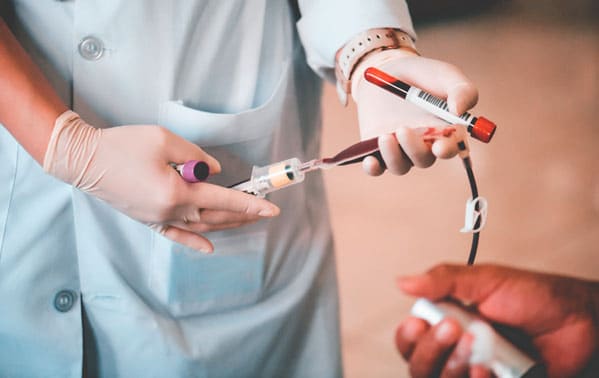Transfusion Management of Beta (β) Thalassemia: Initiating Regular Transfusions
A Thalassemia Resource for People with Thalassemia and their Caregivers
Download and print this page [PDF – 372 KB, 2 Pages]
Key Facts About β Thalassemia

- β thalassemia is an inherited blood disorder (passed from parents to children through genes).
- People with β thalassemia cannot make enough of a protein called globin, an important part of the
hemoglobin that is contained inside red blood cells. - Hemoglobin picks up oxygen in the lungs and takes it to different parts of the body through the bloodstream.
What Happens When Hemoglobin Levels are Low in People with β Thalassemia
When not enough hemoglobin is made, there are fewer red blood cells in the bloodstream, so less oxygen reaches the organs and tissues that need it. This condition is called anemia.


In children with β thalassemia, anemia may cause
- Fatigue and reduced activity
- Growth problems and delayed puberty
- Enlargement of the liver and spleen
- Bone weakening
- Trouble with memory, concentration, or learning new things
In adults with β thalassemia, anemia may cause
- Fatigue and trouble working or performing usual activities
- Bone weakening or fractures
- An overactive spleen that makes it harder to filter old or damaged red blood cells
- Trouble with memory, concentration, or learning new things
- Reduced quality of life
These complications occur because the bone marrow (the dark spongy part in the middle of bones where blood is made) becomes more active. The marrow expands, trying to make up for the anemia by making more red blood cells. These new cells also have reduced hemoglobin levels. When there isn’t enough hemoglobin, the body’s red blood cells don’t function properly, and they last shorter periods of time. This means there are fewer healthy red blood cells traveling in the bloodstream.
Why People with β Thalassemia Need Transfusions
Blood transfusions are used to treat anemia in people with β thalassemia. A blood transfusion is usually a safe, common procedure in which a person receives blood through a tiny plastic tube inserted into one of their veins. A blood transfusion increases the hemoglobin, which reduces the anemia and nearly always makes a person feel better quickly. Healthcare providers might recommend episodic transfusions (only as needed) or regularly occurring transfusions based on a person’s overall health.
Although some types of anemia are treated with iron supplements, taking iron supplements will not help people with β thalassemia. Their anemia is not caused by too little iron in the blood; it is caused by not having enough red blood cells. In fact, taking iron supplements could harm a person with β thalassemia because the extra iron builds up in the body and can cause damage to the organs.
Initiating Regular Transfusions for People with β Thalassemia
Blood hemoglobin is measured in grams per deciliter, written g/dl.
Healthcare providers follow guidelines to decide whether to recommend episodic or regularly occurring transfusions depending on hemoglobin levels, type of thalassemia, and other things found during a physical exam. Most people with β thalassemia whose hemoglobin levels are consistently below 7 g/dl might get regularly occurring transfusions. Regular transfusions are also important, even if a person’s hemoglobin levels are 7 g/dl or higher, if there are other complications such as
- Growth problems or delayed puberty
- Bone deformities or fractures
- An enlarged spleen
- Stroke
- Blood clots
- High blood pressure that affects the lungs and heart
Reference: Lal A, Wong T, Keel S, Pagano M, Chung J, Kamdar A, et al. The transfusion management of beta thalassemia in the United States. Transfusion. 2021; 1–13. https://onlinelibrary.wiley.com/doi/10.1111/trf.16640
The Thalassemia Transfusion Resources were supported by cooperative agreement number CDC-RFA-DD19-1903, funded by the Centers for Disease Control and Prevention (CDC). They were developed by Georgia State University Research Foundation, Inc., Joan & Sanford I. Weill Medical College of Cornell University, and The Regents of the University of California San Francisco in collaboration with CDC. The materials have been developed as a supplemental (user-friendly) resource for healthcare providers, blood banks, and persons with thalassemia and their families to provide key information from a recent evidence-based report that details recommendations for the transfusion management of beta thalassemia in the United States.
These materials are not part of the CDC guidelines and recommendations. The original evidence-based report and recommendations were developed in 2021 by a multi-disciplinary committee, the Thalassemia Western Consortium, consisting of members from 10 hematology centers that was partially funded under a prior cooperative agreement CDC-RFA-DD14-1406. While the Consortium was supported with federal funding, their work on clinical recommendations for transfusion practices was independent of CDC, and the contents of the resulting published report are solely the responsibility of the authors and do not
necessarily represent the official views of, nor an endorsement by, CDC or the Department of Health and Human Services.
